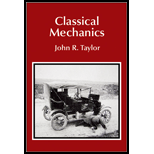
The velocities of the two masses just after the impulse has been applied.
Answer to Problem 3.36P
The total velocity of the left mass is
Explanation of Solution
Write the expression for the
Here,
Write the expression for the
Use equation (II) and (I) to write the expression for the net force on the system.
Here,

Figure
The force exerted on the dumbbell for a short time is called as impulse exerts on the dumbbell. The change in momentum to the dumbbell is equal to the impulse exerts on the dumbbell.
Here,
The initial momentum is zero because initially the dumbbell is at rest.
Write the expression for
Use equation (V) and (III) in (IV) to solve for the momentum.
Write the expression for the final linear momentum of the system consists of mass
Compare the equation (VI) and (VII) to solve for
Write the expression for the torque acting on the dumbbell.
Here,
The torque about the center of mass is pointed into the page or in the
Use equation (X) in (IX) to solve for the torque.
Write the expression for the total angular momentum transferred to the dumbbell during time interval
Here,
Use equation (XI) in (XII) to solve for
Write the general expression for the angular momentum.
Here,
Write the expression for
Use equation (XIII) and (XV) in (XIV) to solve for
Write the expression for the total velocity of the left mass of the dumbbell.
Use equation (VIII) and (XVI) in (XVII) to solve for
Write the expression for the total velocity of the right mass of the dumbbell.
Use equation (VIII) and (XVI) in (XVIII) to solve for
If
If
The velocity of the left mass is equal to the velocity of the right mass when
If
If
The velocity of the right mass is zero.
Conclusion:
Therefore, the total velocity of the left mass is
Want to see more full solutions like this?
Chapter 3 Solutions
Classical Mechanics
 College PhysicsPhysicsISBN:9781305952300Author:Raymond A. Serway, Chris VuillePublisher:Cengage Learning
College PhysicsPhysicsISBN:9781305952300Author:Raymond A. Serway, Chris VuillePublisher:Cengage Learning University Physics (14th Edition)PhysicsISBN:9780133969290Author:Hugh D. Young, Roger A. FreedmanPublisher:PEARSON
University Physics (14th Edition)PhysicsISBN:9780133969290Author:Hugh D. Young, Roger A. FreedmanPublisher:PEARSON Introduction To Quantum MechanicsPhysicsISBN:9781107189638Author:Griffiths, David J., Schroeter, Darrell F.Publisher:Cambridge University Press
Introduction To Quantum MechanicsPhysicsISBN:9781107189638Author:Griffiths, David J., Schroeter, Darrell F.Publisher:Cambridge University Press Physics for Scientists and EngineersPhysicsISBN:9781337553278Author:Raymond A. Serway, John W. JewettPublisher:Cengage Learning
Physics for Scientists and EngineersPhysicsISBN:9781337553278Author:Raymond A. Serway, John W. JewettPublisher:Cengage Learning Lecture- Tutorials for Introductory AstronomyPhysicsISBN:9780321820464Author:Edward E. Prather, Tim P. Slater, Jeff P. Adams, Gina BrissendenPublisher:Addison-Wesley
Lecture- Tutorials for Introductory AstronomyPhysicsISBN:9780321820464Author:Edward E. Prather, Tim P. Slater, Jeff P. Adams, Gina BrissendenPublisher:Addison-Wesley College Physics: A Strategic Approach (4th Editio...PhysicsISBN:9780134609034Author:Randall D. Knight (Professor Emeritus), Brian Jones, Stuart FieldPublisher:PEARSON
College Physics: A Strategic Approach (4th Editio...PhysicsISBN:9780134609034Author:Randall D. Knight (Professor Emeritus), Brian Jones, Stuart FieldPublisher:PEARSON





